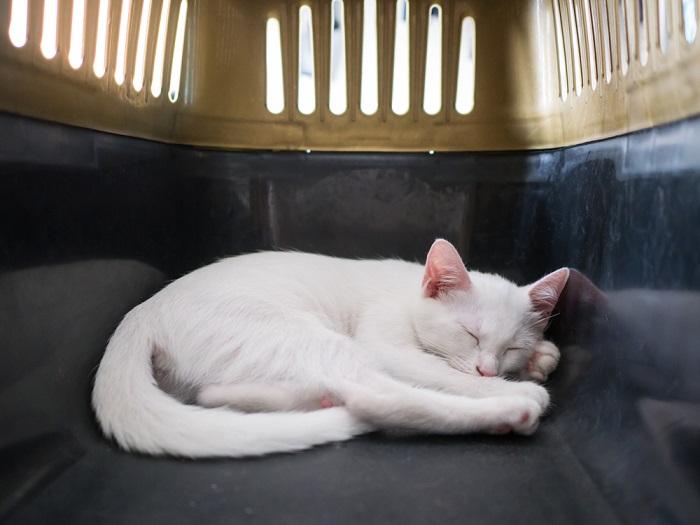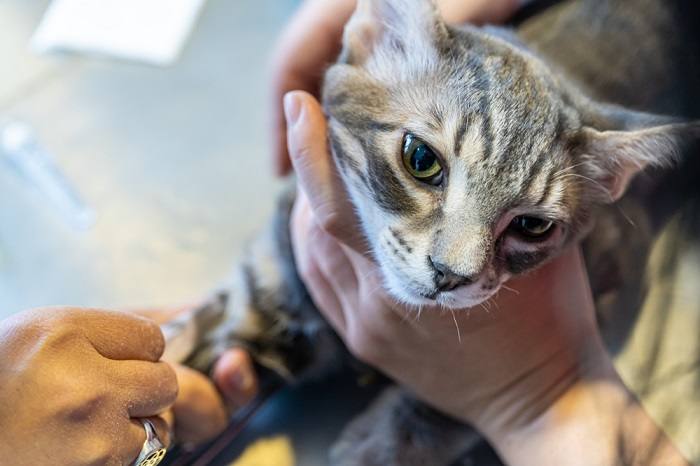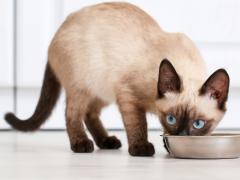
There are occasions cats need sedatives. In this article, we will provide a clear explanation of cat sedatives, the reasons for using them, their effects, and the various sedatives that are available both over the counter and by prescription from their veterinarian.
What Is A Sedative?
People often refer to anti-anxiety medication as sedatives, but there are noted differences between these two types of drugs.
A sedative is a drug that produces a calming or sleep-inducing effect. The term is derived from the Latin word “sedare” meaning “to sit” or “to settle.” The commonly used adjective “sedate,” meaning calm, dignified, and unhurried, comes from the same origin.
A sedative causes a cat to become “sedated” i.e. calm and sleepy. Anti-anxiety medication is slightly different, but the effects are similar. These drugs stop cats from feeling anxious, but they do not induce sleepiness in the same way that sedatives do.
Also Read: The 7 Best Calming Cat Treats
Why Cats May Need Sedatives

When cats are faced with a stressful situation, sedatives may be the answer, depending on the severity of the stress.
Most pet cats are friendly creatures who are relaxed enough to cope with most of the events that happen in daily life. However, some cats are very anxious or fearful, and even calm cats become anxious in certain specific situations.
Fearful cats can be dangerous. They tend to express aggressive behavior to defend themselves if they feel cornered. Sedatives help cats feel calm and sleepy so that they are less fearful. This makes them easier and safer to handle.
The types of situations where cat sedatives are recommended include:
- Visits to veterinarian’s offices – Some cats become defensively aggressive at the vet’s because they are afraid.
- Travel – Many cats become agitated and upset when placed in a carrier for a journey, including long car rides, airline travel, etc. Some sedatives also help with motion sickness.
- Fireworks and thunderstorms – These events are common culprits of inducing anxiety and stress in many kittens and cats.
- Minor procedures – This includes grooming, clipping off matted fur, and activities at the veterinarian’s office, such as blood sampling, nail clipping, ultrasounds, and having x-rays taken.
- Pre-medication prior to general anesthesia – Cats are often given sedatives in the veterinary clinic before being given anesthesia because it tends to reduce the amount of general anesthetic needed. Sedatives also allow for a smoother induction and recovery from anesthesia.
Also Read: How Much Does A Cat X-Ray Cost?
Types Of Cat Sedatives

Talk to your vet to decide which type of sedative is most appropriate for your cat.
The most potent and safest sedatives for cats are prescription-only products. These are only obtained from your veterinarian. If your cat needs a significant level of sedation for any reason, this is always your first choice.
Over-the-counter and natural/home remedies are likely to have a far milder, even imperceptible calming effect on a highly agitated cat, but they have a role in certain situations.
Prescription Only Sedatives
These types of sedatives are divided into two groups: injectable sedatives, and oral sedatives.
1. Injectable Sedatives

Injected sedatives are more intense and they take effect quickly.
Injectables are the most potent and rapidly acting sedative medications. They are only be administered by veterinary professionals. Generally, they are given in-house to hospitalized patients, intravenously (iv), intramuscularly (im), or subcutaneously (sc).
Examples include:
- Medetomidine and dexmedetomidine -These medications belong to a group of drugs known as selective alpha-2 agonists. One of the advantages of these drugs is that they can be reversed rapidly by an injection of atipamezole (Antisedan).
- Acepromazine (“ACP”) – Also given by veterinarians via injection, a tablet version of ACP is sometimes available. This drug is less potent than alpha-2 agonists.
- Other injectable sedatives – Medications used on their own or more commonly as part of a combination of medications. These include butorphanol, methadone, hydromorphone, buprenorphine, midazolam, telazol, ketamine, and fentanyl. Most veterinarians have their own favorite choice of protocol from these types of medications, and most clinics only have a limited number of these types of products available.
These drugs have the potential to be highly dangerous, and they can only be used under very close professional supervision. Vets will use ancillary aids such as heart rate measurement, oxygen supplementation, and availability of antidotes, to minimize the risk to patients.
Also Read: How To Keep Your Cat From Jumping After Surgery
2. Oral Sedatives

Oral sedatives are less potent and take longer to take effect, but they are easier for pet owners to give.
There are sedative tablets, capsules, and gels with sedative effects as well. They tend to be less potent and slower-acting than injectable drugs, but it’s easier for them to be given by owners (e.g., prior to visiting the veterinary office). Examples include:
- Acepromazine is one of the phenothiazine classes of sedatives and has been widely used in the past. However, it should be avoided where there is a possibility of heart disease in a cat as it can have a significant depressive effect on blood pressure. Vets often won’t use this medication in certain breeds of cats that are prone to heart disease. In recent years there have been concerns that the medication may give cats the appearance of sedation while they are still feeling highly anxious inside, but are unable to show this due to the physical sedation. For this reason, other medications are now often preferred.
- Gabapentin is used as a type of painkiller in humans and animals, but it also has anti-epileptic and mildly sedative properties. Some veterinarians suggest that it be given to an anxious cat 90 minutes prior to a visit to the veterinarian.
- Trazodone has an anti-anxiety and sedative effect, with a peak effect 1-3 hours after dosing. Sometimes the use of a combination of gabapentin and trazodone is recommended.
- Diphenhydramine (Benadryl) is an antihistamine medication, often given to treat itchiness linked to allergies. Sedation is a common side effect, so it is popular for this reason alone. Cats with some health issues (including glaucoma, high blood pressure, or urinary problems) should avoid Benadryl.
- Alprazolam (Xanax or other brand names) help with anxiety, but it has less of a sedative effect.
- Selective serotonin reuptake inhibitors (SSRIs) in certain situations.
All of the products above are prescription only, and only to be used under the direct guidance of your veterinarian. A range of possible side effects may occur, and some of them are not safe for every cat. Detailed professional recommendations are essential, with careful measurement of a cat’s body weight and calculation of dosages in mg/kg.
Also Read: Drug Poisoning In Cats: Causes, Symptoms, & Treatment
Over The Counter (OTC) Products
The sedative effect of OTC products is far less pronounced than the impact of prescription-only drugs. They are still beneficial. Here are some of the more popular ones.
- Feliway Spray contains an artificial analog of a feline pheromone, which is an odorless scent produced naturally by cats. Pheromones partly explain why cats like to head-butt people; they are marking them with pheromones produced by skin glands in this area. Feliway is often used to help cats feel calmer and is used to treat urine spraying (or any urination out of the kitty litter box), scratching, fighting, or hiding, as well as for stressful events like car travel, grooming, visits to vets, etc. It is available in either a spray bottle or as a plug-in diffuser. Pheromone collars are also available.
- Purina Calming Care Cat Supplement contains a strain of beneficial bacteria shown to help cats maintain calm behavior. One sachet is given to a cat, once daily, under the direction of your veterinarian.
- Royal Canin Calm Food is formulated to help support emotional regulation, as well as supporting digestive, urinary, and skin health, all of which may be compromised in stressed pets.
- Other proprietary calming products include ingredients such as Thiamine, L-Theanine, and others.
Natural/Home Remedies

Not all cats feel calmed by catnip, although a significant portion of cats have a hereditary reaction to the herb.
Some natural remedies can be helpful if a cat is mildly stressed.
- Catnip, also known as catwort or catmint, is a plant species of the genus Nepeta. It contains a chemical called nepetalactone which makes around two-thirds of cats feel relaxed, causing drooling, sleepiness, and purring. Some cats also seem to get anxious or excited by it, causing them to jump around. One-third of the cat population is not affected by catnip. This is a hereditary effect.
- Rescue Remedy Pet is a combination of five natural flower essences, originally created by Dr. Edward Bach. It provides a natural stress relief for cats and is used for feline stress related to travel, loud noises & stressful events. The recommended dose is four drops per day. This product is alcohol-free and is designed for pets. The human version is not for use in animals. This is not an evidence-based product, but many cat owners find it useful.
Ancillary Approaches To Sedation
Along with using products to help cats stay calmer, feline stress reduction should include reviewing and modifying the cat’s environment, as well as using some behavior modification training. Examples include:
- Survey your home to ensure that it’s as “cat friendly” as possible. Cats enjoy high-up perches, low-down hiding places, scratching posts, plenty of space to escape from other cats, and a range of toys to play with.
- Don’t just pull out a cat’s carrier from a cupboard when it’s time for a car trip. If you do this, the cat will begin to associate the carrier with stressful events and this will increase their fear. Instead, leave the carrier out in the home, with treats and toys placed inside. Over time, the cat may come to view their carrier as a fun place rather than a scary place.
- Many cats feel safe when they are hidden. Covering the sides of a cat’s carrier with sheets or blankets can help to reduce stress when traveling.
Also Read: 5 Reasons Your Cat Is Pacing And How To Help
Side Effects Of Cat Sedatives

Cats under sedation and coming out of sedation need to be monitored closely for any potential side effects.
Different medications have different side effects, so you should ask your vet to discuss these in detail with you before using any sedative product. Common side effects may include:
- Vomiting or diarrhea.
- Dry mouth
- Liver or kidney issues
- Clumsiness or lack of coordination.
- Decreased blood pressure.
- Reduced ability to regulate body temperature, leading to chilling or overheating.
- Excitement, reactivity, or aggression can occasionally occur instead of the desired sedation.
Sedated cats should always be monitored carefully so that any side effects are detected and appropriate action is taken.
Also Read: What Can You Give A Cat For Pain? 6 Vet-Recommended Options
Does Your Cat Need Sedatives?
Learn to understand cat body language so that you can read your cat’s emotions and recognize when they are stressed. This will tell you if and when sedatives or anti-anxiety medication are needed. A cat’s stressed body language includes:
- Tense body
- Ears pressed back or flat against the head.
- Hair standing up, especially hackles along the back.
- Pupils are larger than normal.
- Increased vocalization
- Trying to run away, or hide.
- If cornered, aggression such as hissing, growling, and trying to bite or scratch.
- Loss of appetite.
- Behavioral changes, such as hiding, being less playful, and being more irritable.
- Urinating outside the litter box
Final Thoughts On Cat Sedatives
Cat sedatives are a highly effective way of making stressful situations more tolerable for cats. They also help control the difficult reactive behavior of highly stressed cats, such as aggression or running away, so that veterinarians are able to physically handle their patients. The most effective sedation is carried out under close professional supervision.
Also Read: Best Calming Aid For Cats
Frequently Asked Questions
How can I sedate my cat at home?
You can try the over-the-counter or natural products listed above, or you can discuss prescription-only oral medication with your veterinarian.
Can I use sedatives on my cat?
If your cat is mildly stressed or anxious, try the behavior modification suggestions listed above, as well as the over-the-counter or natural products that are mentioned. If these are not effective enough, discuss stronger prescription-only products with your veterinarian.
How much Benadryl can I give my cat to sedate?
Only give your cat the precise amount of Benadryly by discussing this with your veterinarian. Give them an up-to-date body weight of your cat, so that accurate dosing can be calculated.
How can I sedate my cat for moving?
The over-the-counter and natural options mentioned above should be sufficient, but if your cat is highly anxious, discuss prescription-only alternatives with your veterinarian.







